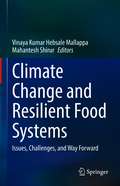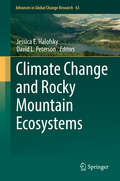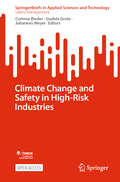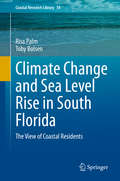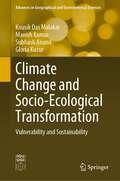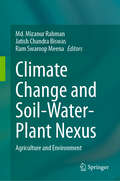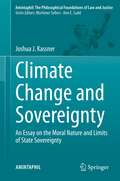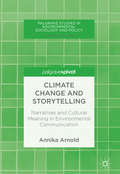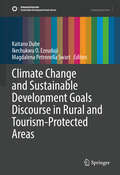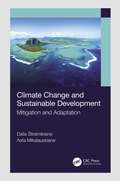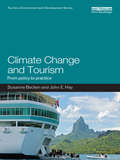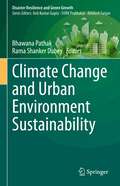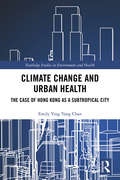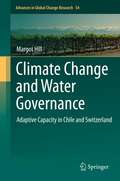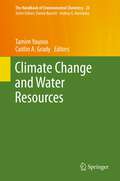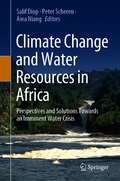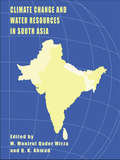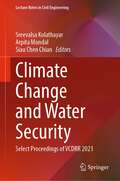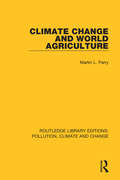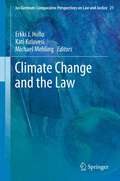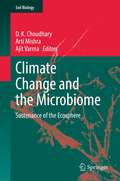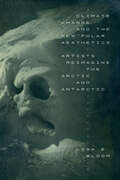- Table View
- List View
Climate Change and Resilient Food Systems: Issues, Challenges, and Way Forward
by Vinaya Kumar Hebsale Mallappa Mahantesh ShirurThis book provides insights on innovative strategies to build resilient food systems in the wake of challenges posed by climate change. Providing food security to the growing population especially in developing countries without exacerbating the environment is a major challenge. Climate change is expected to reduce agricultural productivity, leading to a decline in overall food availability and significantly increasing the number of malnourished children in developing countries. Interventions for enhancing the adaptive capacity of farmers especially of small holders needs immediate impetus. The policy formulation and development programs must reorient in the wake of the new expectations and deliverables. This book comprises of sixteen chapters that discuss the trends in global agriculture development and food system. The book highlights different aspects of household food and nutritional security. The chapters covering diverse aspects address food system, rural and urban food chain, factors affecting their sustainability and short and long term solutions to make them climate resilient. Important issues having significant implications on climate change such as Waste management, Value chain, Agri-marketing, etc. are also covered. The book would be an important resource for researchers in food science, environmental sciences and agriculture. It would also be beneficial for students and future scientists working on sustainable agriculture and food security.
Climate Change and Rocky Mountain Ecosystems (Advances in Global Change Research #63)
by David L. Peterson Jessica E. HalofskyThis book is the result of a team of approximately 100 scientists and resource managers who worked together for two years to understand the effects of climatic variability and change on water resources, fisheries, forest vegetation, non-forest vegetation, wildlife, recreation, cultural resources and ecosystem services. Adaptation options, both strategic and tactical, were developed for each resource area. This information is now being applied in the northern rocky Mountains to ensure long-term sustainability in resource conditions. The volume chapters provide a technical assessment of the effects of climatic variability and change on natural and cultural resources, based on best available science, including new analyses obtained through modeling and synthesis of existing data. Each chapter also contains a summary of adaptation strategies (general) and tactics (on-the-ground actions) that have been developed by science-management teams.
Climate Change and Safety in High-Risk Industries (SpringerBriefs in Applied Sciences and Technology)
by Corinne Bieder Gudela Grote Johannes WeyerThis open access book directs attention to the safety implications of disruptive, sustainability-driven changes in sociotechnical systems resulting from climate-change considerations in high-risk industries. It addresses not only the dismantling of currently prevalent systems and structures and the achievement of a stable future state but also the management of processes for establishing new practices in a safe and reliable manner without undue interruption of important functions and services.Leading scholars from various fields of research have contributed to this brief by analyzing case studies as well as through conceptual and methodological work. They propose strategies for coping with new kinds of risk at local and organizational levels. The oil and gas and nuclear industries are two cases investigated here. They present a challenging mixture of continuity and disruption and require strategies for coping with safety and sustainability issues at the same time. Innovativemethods such as real-world experimentation and computer-based simulation are discussed as means of investigating the issues at stake. Climate Change and Safety in High-Risk Industries brings together critical appraisals of the challenges that will be faced by industry, regulatory bodies and decision-makers in coming decades. It analyzes whether safety and sustainability are accurately thought of as competing imperatives or, rather, offer possibilities for a more cooperative approach to the necessary adaptations in our modes of production and consumption.
Climate Change and Sea Level Rise in South Florida: The View of Coastal Residents (Coastal Research Library #34)
by Risa Palm Toby BolsenSouth Florida is frequently cited as the part of the United State of America as most susceptible to the devastation accompanying sea level rise. Several scholarly studies have shown the negative impact of coastal location in Florida on housing values. Are the residents of South Florida concerned? Is susceptibility to sea level rise actually affecting the housing market in terms of demand, the availability of home mortgages, or house prices? Are people living at particular risk from sea level rise aware of this risk and more open to new information about climate change? Do they support policies and laws to mitigate the pace and extent of climate change? Answers to these questions are not only of general interest, but they are also key to our understanding of the human dimensions of this problem. This book describes the results of a detailed survey in which respondents viewed a local map displaying flooding to their own community that would result from a Category 3 hurricane in 2033. It discusses political party identification and ideology that has an overwhelming impact in shaping views about sea level rise and climate change. This book has enormous implications for the effectiveness of communicating risk information. The text is important if we, as a nation, are to design communication strategies that will lead to broader policy to combat or mitigate this risk.
Climate Change and Socio-Ecological Transformation: Vulnerability and Sustainability (Advances in Geographical and Environmental Sciences)
by Manish Kumar Subhash Anand Kousik Das Malakar Gloria KuzurThis book focuses on various psycho-social and socio-physical aspects of climate change and includes a wide range of case studies. Included topics are notable climate-related social thinking; climate vulnerability; transformation in socio-ecological subsystems; bioclimatological, urban bioclimatological and socio-bioclimatic ideas; disasters; policy instruments; climate justice; human rights; and sustainability. The book distinguishes itself from similar works by including a wide variety of topics and assists policy management in the current and upcoming climate crisis era. This book also addresses the Sustainable Development Goals 13 (Take Urgent Action to Combat Climate Change and Its Impacts), highlighting resilience, recovery potential and adaptive capacity, climate change measures integrated into policies and planning, and knowledge and capacity to mitigate climate change. The ideas covered in this book evolved in response to the current climate crisis, ideas that the authors believe will aid in societal management and development in the present and future. The book is a useful source for planners, geographers, professionals, academics, government officials, laypeople, and others interested in climate change.
Climate Change and Soil Microorganisms for Environmental Sustainability (Microorganisms for Sustainability #28)
by Meenu Saraf Dinesh Kumar Maheshwari Dweipayan GoswamiThis book provides information on the plant-microbe interactions which hold vital implications for addressing the global challenges of climate change, food security and environmental conservation. It also delves into the interconnectedness within the microbial world and its association with plants. The phenomenon of quorum sensing, a bacterial communication method that facilitates collective decision-making, has been discussed as well. The authors illustrate how these mechanisms enable soil microbes to engage in symbiotic relationships with plants, thereby promoting broader environmental sustainability goals. Facing the pressing global issue of climate change, the book elucidates the impact of these symbiotic relationships on climate regulation, tracing how these interactions influence the carbon cycle and greenhouse gases balance. This contributed volume thus weaves a compelling narrative that combines scientific knowledge with the global sustainable development goals. The book is useful for scholars and researchers working in microbiology, botany, ecology, and environmental sciences.
Climate Change and Soil-Water-Plant Nexus: Agriculture and Environment
by Ram Swaroop Meena Md. Mizanur Rahman Jatish Chandra BiswasThe edited book provides a comprehensive and up-to-date overview of scientific developments in agricultural sustainability under changing climate conditions. It focuses on the linkages among soil, water, and crops and their management options to maintain soil health and ensure a sustainable crop production environment. The book addresses the scenarios and challenges of agricultural sustainability in the face of climatic change. With increasing pressure on our limited land and water resources to produce higher crop yields for a growing global population, the efficient use of soil, water, and fertilizers is crucial for achieving most of the United Nations' Sustainable Development Goals (SDGs). The book presents climate change mitigation and adaptation options to help achieve these SDGs. It highlights the impact of climate variability on agricultural production and the functions of ecosystems, emphasizing the importance of developing climate-resilient agriculture to sustain food production and reduce greenhouse gas emissions. The book explores the soil-water-plant nexus and its response to changing climate, characterizing seasonal and inter-annual climatic variability in crop growth and yield. Different chapters evaluate the effects of climate change on soil health degradation, depletion of soil nutrients and carbon contents, and crop responses to climate variability. This book is of interest to academicians, researchers, scientists, capacity builders, and policymakers. Extension personnel will benefit from its insights, and it serves as valuable supporting material for graduate students of agriculture, forestry, ecology, soil science, and environmental sciences in understanding and designing their own research.
Climate Change and Sovereignty: An Essay on the Moral Nature and Limits of State Sovereignty (AMINTAPHIL: The Philosophical Foundations of Law and Justice #10)
by Joshua J. KassnerThis book offers a meditation on global justice and international political and legal theory. The author assesses positions in the current debate over the moral nature and limits of sovereignty. He also evaluates the normative role sovereignty ought to play in the practical deliberations of states. The discussion moves from theory to practice. Coverage starts with a conceptual analysis and moral critique. It then goes on to consider specific issues. These include global climate change, secession and self-determination, human rights, global distributive justice, and immigration. Readers will learn how states ought to deliberate about and respond to these important topics. They will also discover potential institutional structures better suited to resolving these issues while also respecting state sovereignty. In working through each specific challenge, the author provides insight into how we ought to think about challenges facing the international community and the potential for properly constructed institutions to function as solutions. These analyses also provide a valuable critical lens to assess the actions (and omissions) of our leaders. In the end, the book argues that domestic governments and regional bodies should be responsible for implementing the chosen course of action. This would provide a basis for holding political leaders more accountable.
Climate Change and Storytelling: Narratives and Cultural Meaning in Environmental Communication (Palgrave Studies in Environmental Sociology and Policy)
by Annika ArnoldClimate change is as much a cultural phenomenon as it is a natural one. This book is about those cultural patterns that surround our perception of the environmental crisis and which are embodied in the narratives told by climate change advocates. It investigates the themes and motifs in those narratives through the use of narrative theory and cultural sociology. Developing a framework for cultural narrative analysis, Climate Change and Storytelling draws on qualitative interviews with stakeholders, activists and politicians in the USA and Germany to identify motifs and the relationships between heroes, villains and victims, as told by the messengers of the narrative. This book will provide academics and practitioners with insights into the structure of climate change communication among climate advocates and the cultural fabric that informs it.
Climate Change and Sustainable Development Goals Discourse in Rural and Tourism-Protected Areas (Sustainable Development Goals Series)
by Kaitano Dube Magdalena Petronella Swart Ikechukwu O. EzeudujiDespite its potential to unlock socio-economic benefits in rural and protected areas in a manner that addresses the Sustainable Development Goals (SDG), rural and protected areas tourism is yet to be thoroughly examined by academics, scholars, practitioners, and policymakers. This lack of exploration has undermined the potential benefits associated with tourism development in rural and protected areas. Given the complexity of rural tourism, this contributed volume explores current and future debates on the subject using cases in Southern Africa. The book is useful for various audiences, including tourism academics, planners, cultural and heritage practitioners, and rural development planners. The topics covered include gender, transformation, service delivery, visitor experience, wildlife tourism, and host-community tourism interaction.
Climate Change and Sustainable Development: Mitigation and Adaptation
by Asta Mikalauskiene Dalia ŠtreimikienėClimate Change and Sustainable Development: Mitigation and Adaptation focuses on the link between climate change threats and sustainable development goals. This book analyzes the polices of climate change mitigation and adaptation from an economic point of view by addressing globalization, international trade, and business opportunities and challenges. Based on extended research on energy, transportation, agriculture, and more, the case studies included in this book present business opportunities linked to mitigation and adaptation actions; from European Union greenhouse gas emission trading to climate change adaptation policies in developing countries. It presents a framework for the harmonization of climate and sustainable development policies and their mutual outcomes. Specific features: The first book to address main scientific aspects of climate change mitigation and sustainable development and how to deal with these main challenges in a harmonized way Provides practical examples of policies and business development opportunities linked with climate change mitigation and adaptation Analyses climate change challenges and provides implications for business development and good practice case studies from Europe Discusses issues of climate change at different scales ranging from macro to micro level Highlights the importance of climate change adaptation for developing countries, migration trends, city developments and agriculture As the threat of climate change grows ever more present, resources like this book, that provide and discuss necessary solutions and frameworks for ways to deal with and mitigate that threat become ever more essential. This book is a vital resource for academics, students, and professionals in any field seeking to deal with the threats from climate change, and particularly those relating to environmental and climate sciences, as well as those in political and economic fields.
Climate Change and Sustainable Urban Development in Africa and Asia
by Belinda Yuen Asfaw KumssaThis book is about African and Asian cities. Illustrated through selected case cities, the book brings together a rich collection of papers by leading scholars and practitioners in Africa and Asia to offer empirical analysis and up-to-date discussions and assessments of the urban challenges and solutions for their cities. A number of key topics concerning housing, sustainable urban development and climate change in Africa and Asia are explored along with how policy interventions and partnerships deliver specific forms of urban development. It is intended for all who are interested in the state of the cities and urban development in Africa and Asia. Africa and Asia present, in many ways, useful lessons in dealing with the burgeoning urban population, and the problems surrounding this influx of people and climate change in the developing word.
Climate Change and Tourism: From Policy to Practice (Tourism, Environment and Development Series)
by Susanne Becken John HayThe contribution of tourism to climate change, and the likely consequences of climate change for key tourist destinations, has been well reported and discussed. Yet, there is a lack of evidence-based systematic practical advice as to how the tourism industry should respond to the challenge of climate change. Building on a sound conceptual understanding of the links between climate change and tourism, this book shows how the tourism sector might best respond. It not only focuses on the roles of supportive policies and institutions in ensuring a strong "enabling environment" for practical responses, but also on the practical responses themselves. This practical approach is presented through a large number of case studies and examples which illustrate how policy and industry initiatives have been implemented in tourism, and if or why they were successful. The majority of examples come from places such as the Caribbean, Spain, the Maldives, Nepal, and the UK, as well as Australia, New Zealand and other parts of the Pacific. The examples are presented within an overall framework that facilitates the translation of adaptation and mitigation policies into practice. This book offers the tourism industry, students and academics the opportunity to advance from the earlier, more conceptual texts on tourism and climate change by taking a much more practical approach. Its global coverage, through the use of international case studies, fosters a cross-fertilisation of ideas and initiatives. This text provides a detailed analysis of best practices in the face of climate change, across countries and geographically diverse tourist destinations and operations.
Climate Change and Urban Environment Sustainability (Disaster Resilience and Green Growth)
by Bhawana Pathak Rama Shanker DubeyThis book covers the understanding on relationship between climate change, urban development, and environment sustainability with emphasis on relevant issues and challenges of urban environment sustainability. It deals with the concept of climate resilient urban development, effective implementation of climate change adaptation and mitigation actions to promote urbanization from a social, economic, and environmental perspective. Climate change is a critical issue and having serious concern. Understanding the mechanism of climate change and climate variability is an important aspect and requires monitoring in their regional perspectives.Smart and resilient urbanization are essential in tackling the growing threat of climate instability. Different analytical and practical approaches to foster resilience and environmental sustainability in urban areas covering the recent trends, developments and tools related to urban environment, sustainability, and climate change. There is a big demand of understanding on the relationship between climate change, urban environment sustainability due to fast urbanization and an urgent need for constructive and effective mechanism to protect the life and property of human being from expected or anticipated hazards and disasters. This book is of interest and useful to academicians, researchers, scientists, environmentalists, land resource managers, climate change scientists, forest administrators. Also, the book serves as a reference to researchers and students of agriculture, forestry, ecology, soil science, and environmental sciences. Policy makers will also find this to be a useful read.
Climate Change and Urban Health: The Case of Hong Kong as a Subtropical City (Routledge Studies in Environment and Health)
by Emily Ying ChanThis book provides a theoretical framework and related technical skills for investigating climate change and its public health consequences and responses with a focus on urban settings, and in particular Hong Kong, a subtropical metropolis in Asia. Specifically, the book examines the impact of climate change on health in terms of mortality, hospital admissions and help-seeking, as well as key response strategies of adaptation and mitigation. Many existing books tend to consider the relationship of climate change and public health as two connected issues divided into various discrete topics. Conversely, this book explicitly applies public health concepts to study the human impact of climate change, for example, by conceptualising climate change impact and its alleviation, mitigation and adaptation in a public health framework. Overall, this volume summarises what is known about climate change and health and ignites further debates in the area, especially for urban subtropical communities from within a wider global perspective. This book will be of great interest to students and scholars of environmental health, public health, climate change, urban studies and Asian studies.
Climate Change and Water Governance: Adaptive Capacity in Chile and Switzerland (Advances in Global Change Research #54)
by Margot HillThe book presents detailed case studies examining the Rhône Basin in the Canton Valais, Switzerland and the Aconcagua Basin in Valparaiso, Chile. In order to understand and assess the interplay of complex and interlinked environmental and socio-economic issues, the author looks beyond the technology, modelling, engineering and infrastructure associated with water resources management and climate change adaptation, to assess the decision-making environment within which water and adaptation policy and practices are devised and executed.
Climate Change and Water Resources (The Handbook of Environmental Chemistry #25)
by Tamim Younos Caitlin A. GradyThis volume presents nine chapters prepared by international authors and highlighting various aspects of climate change and water resources. Climate change models and scenarios, particularly those related to precipitation projection, are discussed and uncertainties and data deficiencies that affect the reliability of predictions are identified. The potential impacts of climate change on water resources (including quality) and on crop production are analyzed and adaptation strategies for crop production are offered. Furthermore, case studies of climate change mitigation strategies, such as the reduction of water use and conservation measures in urban environments, are included. This book will serve as a valuable reference work for researchers and students in water and environmental sciences, as well as for governmental agencies and policy makers.
Climate Change and Water Resources in Africa: Perspectives and Solutions Towards an Imminent Water Crisis
by Salif Diop Peter Scheren Awa NiangThe focus of this book is on the key water-related vulnerabilities to climate change in Africa, particularly in its most vulnerable areas, exploring potential management responses to such vulnerabilities. The African countries are particularly exposed and vulnerable to the negative impacts of climate change, with important impacts on water resources and hydrological systems, water availability, water resource management and sea level variations. Already, under various anthropogenic pressures, the status of water resources in Africa has been changing over the past decades, with decreasing water quality, falling groundwater levels, and variability in rainfall, both in terms of timing and intensity. Climate change will further accelerate the rate of change, affecting the ability of people and societies to respond in a timely manner. It is clear that there is no quick fix to the pressures imposed on water resources by climate change. Increasing the resilience of ecosystems and communities to extreme events such as flooding and drought, and integrating climate change risks and opportunities into development decision-making is indeed a key challenge, as much a technical climate-change one, as a political and developmental challenge. The book, in this regard, intends to contribute to the debate around climate change in relation to water resources management in Africa, and in particular inform policy decisions and actions that will improve governments’ and communities’ ability to manage the challenges of climate change and variability in relation to the aquatic ecosystems that they depend on. The knowledge collected in this book will benefit policy makers, researchers, as well as other stakeholders.
Climate Change and Water Resources in South Asia
by M. Monirul Qader Mirza Q. K. AhmadThis book addresses the most pressing water resource issues in South Asia, particularly in relation to climate change and variability. This is a region characterised by abundant water during the monsoon, when devastating floods occur, and by scarcity of water and droughts during the dry period. These extreme events often cause substantial damage to
Climate Change and Water Security: Select Proceedings of VCDRR 2021 (Lecture Notes in Civil Engineering #178)
by Sreevalsa Kolathayar Siau Chen Chian Arpita MondalThis book presents the select proceedings of the Virtual Conference on Disaster Risk Reduction (VCDRR 2021). It emphasizes on the role of civil engineering for a disaster resilient society. It presents latest research on climate change and water security focusing on disaster risk reduction. Various topics covered in this book are climate change, stormwater management, flood risk analysis, drought management, water treatment, etc. This book is a comprehensive volume on disaster risk reduction (DRR) and its management for a sustainable built environment. This book is useful for the students, researchers, policy makers and professionals working in the area of civil engineering, climate change and disaster management.
Climate Change and World Agriculture
by Martin L. ParryOriginally published in 1990, this book analysed the sensitivity of the world food system and looked at the variety of ways in which it would be affected by climate change. It describes the effects of climate change on agriculture, estimates the impacts on plant and animal growth and looks at the geographical limits to different types of farming. It also considers the range of possible ways to adapt agriculture and so to mitigate the disastrous consequences of climate change.
Climate Change and its Effects on Water Resources: Issues of National and Global Security (NATO Science for Peace and Security Series C: Environmental Security)
by Alper Baba Antonio Chambel Gökmen Tayfur Ken W.F. Howard Michael J. Friedel Orhan GündüzNational and global security can be assessed in many ways but one underlying factor for all humanity is access to reliable sources of water for drinking, sanitation, food production and manufacturing industry. In many parts of the world, population growth and an escalating demand for water already threaten the sustainable management of available water supplies. Global warming, climate change and rising sea level are expected to intensify the resource sustainability issue in many water-stressed regions of the world by reducing the annual supply of renewable fresh water and promoting the intrusion of saline water into aquifers along sea coasts, where 50% of the global population reside. Pro-active resource management decisions are required, but such efforts would be futile unless reliable predictions can be made about the impact of the changing global conditions on the water cycle and the quality and availability of critical water reserves. Addressing this wide spectrum of issues, a team of expert authors discusses here the impacts of climate change on the global water resources, the long-term resource management goals at global and local scales, the data requirements and the scientific and technical advances necessary to mitigate the associated impacts.
Climate Change and the Law (Ius Gentium: Comparative Perspectives on Law and Justice #21)
by Michael Mehling Kati Kulovesi Erkki J. HolloClimate Change and the Law is the first scholarly effort to systematically address doctrinal issues related to climate law as an emergent legal discipline. It assembles some of the most recognized experts in the field to identify relevant trends and common themes from a variety of geographic and professional perspectives. In a remarkably short time span, climate change has become deeply embedded in important areas of the law. As a global challenge calling for collective action, climate change has elicited substantial rulemaking at the international plane, percolating through the broader legal system to the regional, national and local levels. More than other areas of law, the normative and practical framework dedicated to climate change has embraced new instruments and softened traditional boundaries between formal and informal, public and private, substantive and procedural; so ubiquitous is the reach of relevant rules nowadays that scholars routinely devote attention to the intersection of climate change and more established fields of legal study, such as international trade law. Climate Change and the Law explores the rich diversity of international, regional, national, sub-national and transnational legal responses to climate change. Is climate law emerging as a new legal discipline? If so, what shared objectives and concepts define it? How does climate law relate to other areas of law? Such questions lie at the heart of this new book, whose thirty chapters cover doctrinal questions as well as a range of thematic and regional case studies. As Christiana Figueres, Executive Secretary of the United Nations Framework Convention on Climate Change (UNFCCC), states in her preface, these chapters collectively provide a "review of the emergence of a new discipline, its core principles and legal techniques, and its relationship and potential interaction with other disciplines."
Climate Change and the Microbiome: Sustenance of the Ecosphere (Soil Biology #63)
by Ajit Varma D. K. Choudhary Arti MishraThis book highlights the impact of climate change on the soil microbiome and its subsequent effects on plant health, soil-plant dynamics, and the ecosphere. It also discusses emerging ideas to counteract these effects, e.g., through agricultural applications of functional microbes, to ensure a sustainable ecosystem.Climate change is altering the soil microbiome distributions and thus the interactions in microbiome and plant‐soil microorganism. Improvement of our understanding of microbe-microbe and plant-microbe interaction under changing climatic conditions is essential, because the overall impact of these interactions under varying adverse environmental conditions is lacking. This book has been designed to understand the impact of climate change, i.e., mainly salt and drought stress, on the soil microbiome and its impact on plant, yield, and the ecosphere.The book is organized into four parts: The first part reviews the impact of climate change on the diversity and richness of the soil microbiome. The second part addresses effects of climate change on plant health. The third part discusses effects on soil-plant dynamics and functionality, e.g., soil productivity. The final part deals with the effects of climate change on ecosystem functioning and also discusses potential solutions.The book will appeal to students and researchers working in the area of soil science, agriculture, molecular biology, plant physiology, and biotechnology.
Climate Change and the New Polar Aesthetics: Artists Reimagine the Arctic and Antarctic
by Lisa E. BloomIn Climate Change and the New Polar Aesthetics, Lisa E. Bloom considers the ways artists, filmmakers, and activists engaged with the Arctic and Antarctic to represent our current environmental crises and reconstruct public understandings of them. Bloom engages feminist, Black, Indigenous, and non-Western perspectives to address the exigencies of the experience of the Anthropocene and its attendant ecosystem failures, rising sea levels, and climate-led migrations. As opposed to mainstream media depictions of climate change that feature apocalyptic spectacles of distant melting ice and desperate polar bears, artists such as Katja Aglert, Subhankar Banerjee, Joyce Campbell, Judit Hersko, Roni Horn, Isaac Julien, Zacharias Kunuk, Connie Samaras, and activist art collectives take a more complex poetic and political approach. In their films and visual and conceptual art, these artists link climate change to its social roots in colonialism and capitalism while challenging the suppression of information about environmental destruction and critiquing Western art institutions for their complicity. Bloom’s examination and contextualization of new polar aesthetics makes environmental degradation more legible while demonstrating that our own political agency is central to imagining and constructing a better world.
